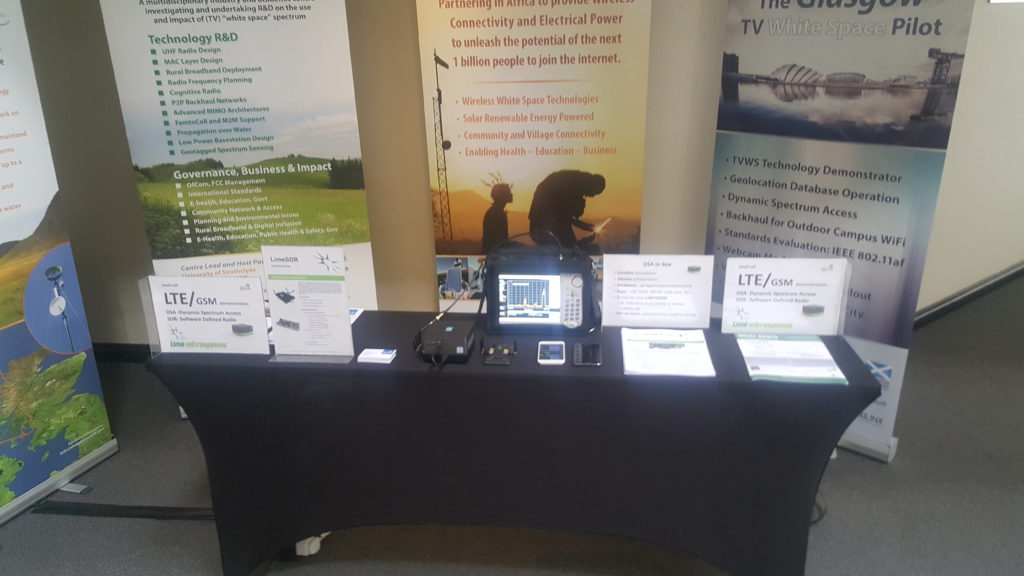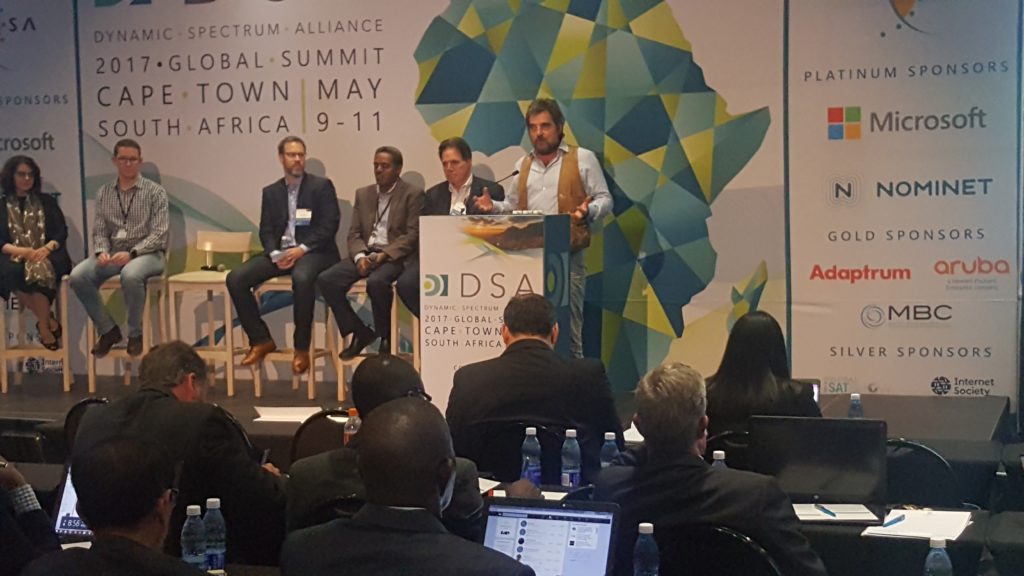Dynamic Spectrum Alliance Global Summit
11th May 2017
The Centre for White Space Communication [CWSC] attended the Dynamic Spectrum Alliance [DSA] Global Summit in Cape Town, South Africa. This three-day event brought together representatives from twenty-one countries across five continents, including various regulators, policy makers, members of academia and both public and private sector representatives.
The event was co-hosted by the Independent Communications Authority of South Africa [ICASA] and sponsored by a number of large tech companies, including Microsoft and Nominet.
For the first time, the DSA formally recognised and celebrated the achievements of its members through an award ceremony. The CWSC was honoured to receive “The Award for a Student-Led initiative or Research on New Opportunities for Dynamic Spectrum Access”, in recognition of its successful leadership on multiple key dynamic spectrum projects.
Proceedings began on Tuesday the 9th, with a regulator workshop on spectrum sharing and dynamic spectrum access.
The Opening Keynote Address was delivered on Wednesday the 10th, by Mr. Kalpuk Gude, President of the DSA, alongside Mr. Henry Kanor.
Following this, Mr. Gude was joined by Mr. Paul Garnett, Chairman of the DSA and Senior Director at Microsoft, to speak about spectrum requirements for the next generation internet and the benefits of dynamic access.
Before the conference broke for lunch Mr. Frank Coster, the General Manager of Microsoft 4Afrika Initiatives, chaired a panel featuring industry leaders from the finance community, commercial network operators and government representatives. Discussion focussed on addressing the financial challenges associated with closing the Digital Divide.
Over the break, CWSC exhibited several of our recent dynamic spectrum projects, in addition to the LimeNET – a “network-in-a-box” product created by Lime Microsystems. This system uses the open-source Lime software defined radio [SDR] board in combination with an Intel i7 processor to create something ideal for high data rate communication applications such as 2-5G radio and IoT nodes.

In the early afternoon, Mr. Gude chaired a discussion panel on the future of Wi-Fi in a 5G world. The panel explored the possibilities in a more spectrally efficient environment, among other advancements.
Following this, Mr. Peter Flynn spoke of the recent developments in Satellite broadband communication, including its potential role in 5G applications.
The afternoon concluded with a panel on Enabling IoT through Dynamic Spectrum Access Technologies. The session was chaired by Dr. Michael Calabrese, director of the Wireless Future Project, and featured the Centre’s own Mr. Malcom Brew, who was on-hand to provide his considerable experience working with Kenyan based Mawingu Networks.

The evening session concluded with the Conference Gala Dinner and the first ever DSA Awards Ceremony. Six individuals and organisations were recognised for their efforts in furthering innovation, increasing inclusion and pursuing new opportunities in dynamic spectrum access.
Among the recipients was Tim Hobbs, who collected the “Award for Increasing Digital Inclusion” as a representative of Mawingu Networks. The company were recognised for their utilisation to TVWS and solar powered basestations to deliver broadband access.
Speaking after the ceremony Hobbs said, “Our business aims to extend Internet connectivity to people who find it out of reach due to cost. Therefore, we are changing the lives of our customers by enabling them to reap the benefits of being connected”.
Dr. David Crawford accepted “The Award for a Student-Led initiative or Research on New Opportunities for Dynamic Spectrum Access” on behalf of the CWSC. The award was presented for the Centre’s work on multiple dynamic spectrum projects across a range of technical areas. This included the development of renewable powered basestations, the contributions to the Ofcom TVWS regulations and the use of dynamic spectrum to bring connectivity to rural and digitally excluded communities.

Commenting on the future of dynamic spectrum, Dr. Crawford said “It is clear that the dynamic management of spectrum is increasingly being recognized as a key important factor for future wireless connectivity solutions, facilitating more efficient and effective use of spectrum. This will ultimately lead to better and more far-reaching connectivity for a range of applications, including affordable access to the Internet for people in hard-to-reach geographic locations, as well as new IoT and 5G applications and use cases”.
The Keynote Addresses on Thursday 11th were given by Mr. Garnett and Mr. Ira Keltz, Deputy Chief of the Policy and Rules Division at the FCC.
This was then followed by a panel co-chaired by Mr. Gude and Mr. Mario Maniewicz, Deputy Director at the International Telecommunications Union. Discussion was centred around addressing various legal and policy challenges associated with spectrum sharing, with a panel featuring regulator representatives from a number of countries.
The morning Technical Keynote Addresses were delivered by several technical and academic representatives, including Mr. Haiyun Tang, CEO of Adaptrum, and Mr. Adam Lech, from Nominet. Among these, representing the CWSC, Professor Bob Stewart speaking on the various dynamic spectrum endeavours undertaken by the Centre, the role of software defined radio [SDR] in 5G applications and the impact of Mawingu Networks.

Professor Stewart went on to speak about the Scotland Innovation Programme, an open collaborative framework for companies or individuals to contribute, by creating or participating in innovative projects which support the Scottish Government’s ambition for the availability of world class digital connectivity. The organisation is made up of a number of industry and academic partners including Facebook, BT, Google and Lime Microsystems to name a few, with the aim of collaborating to test and evolve towards 5G, with particular emphasis on remote and rural communities.
Finally, Professor Stewart announced the award of a Global Challenges Research Funding grant, marking the beginning of a new project at the University of Strathclyde. The UK Government via EPSRC, the Engineering and Physical Science Research Council, will fund a project on “Enabling Affordable Internet Access using Dynamic Spectrum Access and Software Defined Radio”.
This project will have collaboration between 5 academic partners across a number of participating countries; Scotland (UK), Zambia, Ghana, Malawi and Kenya. The project aim, over a year period, is to investigate how the use of dynamic spectrum access management and geo-location database technology, combined with SDR implementations to enable effective and efficient wireless networks to be built at scale to support affordable Internet.
Following the Technical Keynotes and lunch break, Mr. Maniewicz delivered a presentation on behalf of the ITU.
The concluding panel was chaired by Professor H Nwana, Executive Director of the DSA. This discussion, featuring Tim Hobbs of Mawingu Networks, focused on the creation of opportunities for network deployment, and the role of dynamic spectrum access policies. The closing remarks of the DSA Global Summit were given by Mr. Gude.
The video below shows some of the highlights from the Centre’s visit to Cape Town, including the DSA Award ceremony.
The full summit Agenda, including copies of the various delivered presentations, can be found here.
The official press releases from the DSA can be found here.
More information on the Scottish Innovation Programme can be found here.
More information on the EPSRC “Enabling Affordable Internet Access using Dynamic Spectrum Access and Software Defined Radio” project can be found here.
More information on the Centre’s various dynamic spectrum projects can be found here

